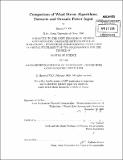Comparison of wind stress algorithms, datasets and oceanic power input
Author(s)
Yuan, Shaoyu
DownloadFull printable version (35.18Mb)
Other Contributors
Woods Hole Oceanographic Institution.
Advisor
Carl Wunsch.
Terms of use
Metadata
Show full item recordAbstract
If the ocean is in a statistically steady state, energy balance is a strong constraint, suggesting that the energy input into the world ocean is dissipated simultaneously at the same rate. Energy conservation is one of the most important principles in the natural world. However, the study of energy balance in the oceanic circulation has long been overlooked. Mink and Winch (1998) proposed that energy is needed to maintain the meridional overturning circulation and they also concluded that the wind energy input into the world ocean constitute the most important part. Since then, many estimates on the wind energy input have been given with a focus on different time and spatial scales. It is well known that it is the air-sea momentum flux (wind stress) that actually drives the ocean circulation, especially the upper layer circulation. Due to the difficulties of directly measuring the wind stress, different algorithms were proposed to relate the wind stress with the wind velocity and other related atmospheric and oceanic variables. Different algorithms in fact produce quite different wind stresses, which may leads to spurious estimates in the wind energy input into the world ocean. The thesis is organized as follows. In chapter 1, we try to understand the difference of four bulk algorithms, and conclude that different bulk algorithms may yield the wind energy input differences of 20%. Comparison of 4 different wind stress dataset were presented in Chapter 2. However, we do not determine which product is the best. In Chapter 3, a simple numerical experiment was executed and some preliminary estimate on the effects of introducing the wind stress dependence on the oceanic surface velocity were given. The ECCO data computation, however, does not produce the results as expected and some explanations are given.
Description
Thesis (S.M.)--Joint Program in Physical Oceanography (Massachusetts Institute of Technology, Dept. of Earth, Atmospheric, and Planetary Sciences; and the Woods Hole Oceanographic Institution), 2009. Includes bibliographical references (leaves 49-51).
Date issued
2009Department
Joint Program in Physical Oceanography; Woods Hole Oceanographic Institution; Massachusetts Institute of Technology. Department of Earth, Atmospheric, and Planetary SciencesPublisher
Massachusetts Institute of Technology
Keywords
Joint Program in Physical Oceanography., Earth, Atmospheric, and Planetary Sciences., Woods Hole Oceanographic Institution.